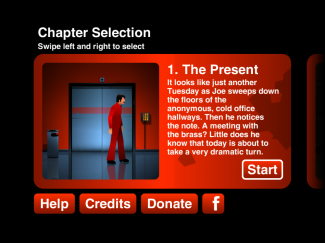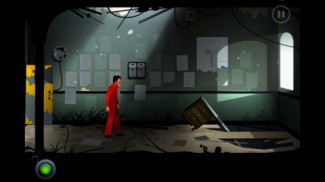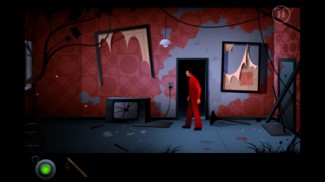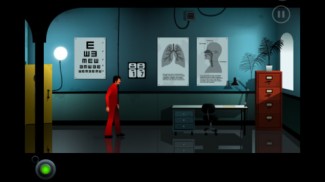Bastion
LQ: 9.15
Recommended Age: 10+
Skills Used: Planning, Working Memory, Mathematics, Reading

The Silent Age is a point-and-click adventure game that puts players in control of Joe, an average janitor who is thrown into remarkable circumstances. Joe’s life is quickly turned upside down as he meets a time traveler who informs him that the world will end unless he is able to stop it. Joe receives a time traveling device which players will later use as one of many tools for solving the game’s various puzzles. Players spend their time working through the different settings of the game, gathering important information, tools, and plot points. Each new setting requires players to solve a series of puzzles in order to advance. Whether searching for the key to a locked door, figuring out how to fix the tire on an ambulance, or searching for the address of the mysterious time traveler, players must utilize the available items and clues in their environment to progress. Episode One of The Silent Age involves five chapters and introduces players to the gameplay and storyline. The game does contain some mild cartoonish violence and dark themes, as well as some mild language and is therefore recommended to players ages 10 and up.
Teachers: check out the classroom guide!
Adapting and adjusting to changing conditions and expectations.
 Players will exercise the Flexibility thinking skill while playing The Silent Age when solving a wide variety of puzzles. The game is broken into chapters, each chapter containing a small amount of contained settings. Players will direct Joe to search for clues and useful tools with which to manipulate Joe's environment. Small clues are given to players through Joe's inner monologue or from the surrounding environment. Players must determine where and how to use the tools they scavenge in order to progress the storyline. For example, when escaping from the police station, Joe must determine the best way to get out of the building. Players must successfully locate a number of keys and other useful items and determine the most effective places to utilize each tool. Each scenario presents a new set of obstacles and a new set of unique tools with which to overcome the obstacles. Players who are able to think flexibly about their environment and available tools will find great success in The Silent Age.
Players will exercise the Flexibility thinking skill while playing The Silent Age when solving a wide variety of puzzles. The game is broken into chapters, each chapter containing a small amount of contained settings. Players will direct Joe to search for clues and useful tools with which to manipulate Joe's environment. Small clues are given to players through Joe's inner monologue or from the surrounding environment. Players must determine where and how to use the tools they scavenge in order to progress the storyline. For example, when escaping from the police station, Joe must determine the best way to get out of the building. Players must successfully locate a number of keys and other useful items and determine the most effective places to utilize each tool. Each scenario presents a new set of obstacles and a new set of unique tools with which to overcome the obstacles. Players who are able to think flexibly about their environment and available tools will find great success in The Silent Age.
Recalling and retaining information in our mind while working.
 Gathering information in The Silent Age requires players to explore their environment, searching for useful tools and clues. Each puzzle requires players to execute tasks in a particular order. What may seem unimportant initially may factor into solving the puzzle later. Players must be aware of the game environment, making note of potentially important clues and information for later. For example, in one chapter, players locate an out-of-place shape covered in dust on the ground with which they are unable to interact. While exploring and completing other puzzles, players obtain a broom and hook. Remembering the shape on the ground and the clue that it was "covered in dust," players can return to clear off the dust revealing a manhole cover which is now easily removed with the hook. Working Memory is an essential component to The Silent Age which presents information and clues in a seemingly random order. Players must be able to recall this information in order to maximize their success at solving each puzzle.
Gathering information in The Silent Age requires players to explore their environment, searching for useful tools and clues. Each puzzle requires players to execute tasks in a particular order. What may seem unimportant initially may factor into solving the puzzle later. Players must be aware of the game environment, making note of potentially important clues and information for later. For example, in one chapter, players locate an out-of-place shape covered in dust on the ground with which they are unable to interact. While exploring and completing other puzzles, players obtain a broom and hook. Remembering the shape on the ground and the clue that it was "covered in dust," players can return to clear off the dust revealing a manhole cover which is now easily removed with the hook. Working Memory is an essential component to The Silent Age which presents information and clues in a seemingly random order. Players must be able to recall this information in order to maximize their success at solving each puzzle.
Use this Play Together guide to learn how you can help your child turn The Silent Age play time into a positive learning and relationship-building experience. To learn more about why playing games with your children is so important, check out our Science of Play page.
Take a minute to talk with your child about how the Flexibility and Working Memory thinking skills work, and why they are important for success in school and at home.
 The Silent Age is a single player game, but is great for cooperative puzzle solving on the same mobile device. Take turns solving puzzles, or work together to search for clues and useful tools.
The Silent Age is a single player game, but is great for cooperative puzzle solving on the same mobile device. Take turns solving puzzles, or work together to search for clues and useful tools.
Gameplay Goals:
After you've found the keys for the ambulance and escaped from the hospital, take a moment to discuss the importance of the thinking skills at play with your child.
Our Make it Work activities are designed to transform your child’s gameplay to real-world improvements in thinking and academic skills. If you’re just getting started with LearningWorks for Kids, we suggest you try them all to find which are the best for you and your child.
Read over the pages for Flexibility and Working Memory. Then take some time to introduce these skills to your child.
Explain that:
 Get unstuck. Get stuck and then unstuck again in front of your kids. One of the best ways for children to learn about Flexibility skills is to see how other people resolve their own difficulties. Let your child observe you in problem solving, even if you are unsure of whether you will be able to overcome the difficulty. Model talking your way through a problem in which you are stuck. Children who are inflexible tend to believe that there is nothing that they can do to change a difficult situation. Even if you encounter a situation where there is no clear resolution, demonstrate some brainstorming skills about potential methods to solve the problem in front of you. Be sure to introduce perspective to help your child to realize that some problems simply go unsolved.
Get unstuck. Get stuck and then unstuck again in front of your kids. One of the best ways for children to learn about Flexibility skills is to see how other people resolve their own difficulties. Let your child observe you in problem solving, even if you are unsure of whether you will be able to overcome the difficulty. Model talking your way through a problem in which you are stuck. Children who are inflexible tend to believe that there is nothing that they can do to change a difficult situation. Even if you encounter a situation where there is no clear resolution, demonstrate some brainstorming skills about potential methods to solve the problem in front of you. Be sure to introduce perspective to help your child to realize that some problems simply go unsolved.
Practice, practice, practice, and practice some more. Working Memory requires the individual to use his cognitive resources for memory. Strategies that make a particular process “automatic,” such as over-learning multiplication tables, reduces the burden on working memory capacity. Provide “attention breaks” in which your child takes a break from the assigned material for a few minutes. This could help your child to regain focus and prevent drifting off task. By practicing and repeating lessons, your child can continue to stretch working memory capacities.
 The Silent Age provides players with clues, information, and plot points completely via textual information. Players must practice close reading, searching for the sometimes subtle clues that will help them solve the game's puzzles. The game can help players practice close and effective reading. The game also provides players with a narrative, advancing the story line through reading. Without reading clues, players will be unable to complete each puzzle.
The Silent Age provides players with clues, information, and plot points completely via textual information. Players must practice close reading, searching for the sometimes subtle clues that will help them solve the game's puzzles. The game can help players practice close and effective reading. The game also provides players with a narrative, advancing the story line through reading. Without reading clues, players will be unable to complete each puzzle.
All membership plans come with full access to our entire suite of tools learning guides, and resources. Here are a few of the ones we think you’ll like the most: